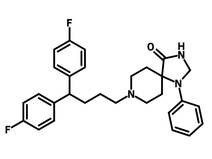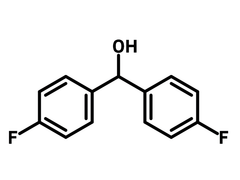Bis(4-fluorophenyl)methanol
CAS Number 365-24-2
Chemistry Building Blocks, Fluorinated Building Blocks, Materials, MonomersA fluorinated diphenylmethanol building block
Used as a synthesis intermediate for APIs and macromolecules
Specifications | MSDS | Literature and Reviews
Bis(4-fluorophenyl)methanol (CAS number 365-24-2), also referred to as 4,4'-difluorobenzhydrol, is a diphenyl methanol building block with two fluorine atoms at the para-position. Bis(4-fluorophenyl)methanol is an important building block for synthesizing antipsychotic drug such as fluspirilene, pimozide and penfluridol. Bis(4-fluorophenyl)methanol is also used in the total synthesis of Tunicamycin V, a homologous nucleoside antibiotic.

Bis(4-fluorophenyl)methanol is used to synthesise aromatic polyethers through nucleophilic aromatic substitution. The free hydroxy groups can be further functionalized for graft polymer with 'grafting to' method.
Multiple functional groups
For facile synthesis
Fluorinated benzonitrile building block
For drug discovery and polymer chemistry
Worldwide shipping
Quick and reliable shipping
High purity
>98% High purity
General Information
| CAS Number | 365-24-2 |
| Chemical Formula | C13H10F2O |
| Full Name | 4,4'-Difluorobenzhydrol |
| Molecular Weight | 220.22 g/mol |
| Synonyms | 4,4′-Difluorobenzhydrol, Bis(4-fluorophenyl) carbinol, 4,4'-Difluorobenzhydryl alcohol |
| Classification / Family | Fluorinated building block, APIs, Graft polymers, Functional polymers |
Chemical Structure

Product Details
| Purity | 98% |
| Melting Point | Tm = 43 – 45 °C |
| Appearance | White to off-white powder |
MSDS Documentation
 Bis(4-fluorophenyl)methanol MSDS Sheet
Bis(4-fluorophenyl)methanol MSDS Sheet
Literature and Reviews
-
An improved total synthesis of tunicamycin V, K. Mitachi et al., MethodsX, 10, 102095(2023); DOI: 10.1016/j.mex.2023.102095.
-
Design and synthesis of novel poly (aryl etherketones) containing trifluoromethyl and trifluoromethoxy groups, X. Liu et al., Des. Monomers Polym., 26(1), 140–149(2023); DOI: 10.1080/15685551.2023.2205733.
-
Preparation and characterization of fluorine-containing aromatic condensation polymers VIII. Aromatic polyether and copolyethers from 2,2-bis(4-hydroxyphenyl)-1,1,1,3,3,3-hexafluoropropane, 2,2-bis(4-hydroxyphenyl)propane, or both and bis(4-fluorophenyl)phenylphosphine oxide, Y. Saegusa et al., Polym. J., 37(6), 399–403(2005); DOI: 10.1295/polymj.37.399.
